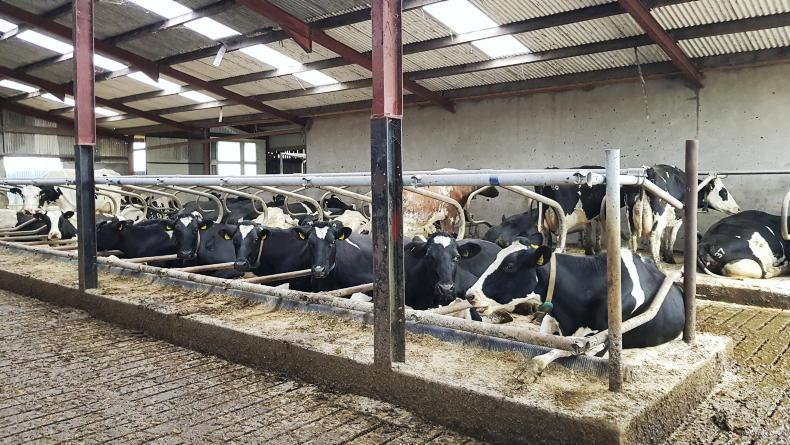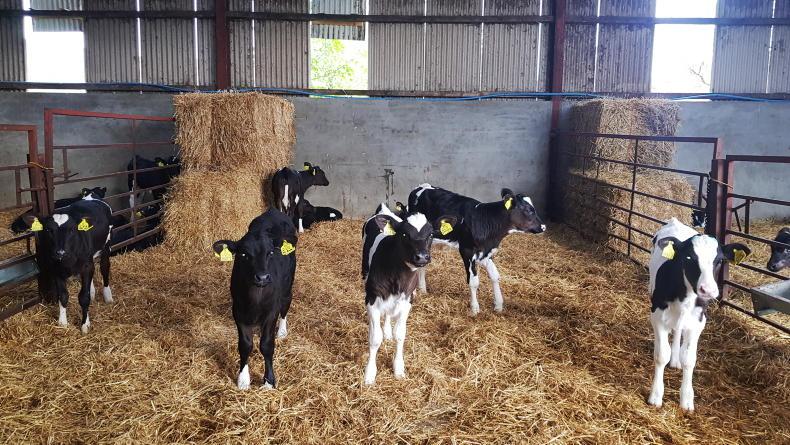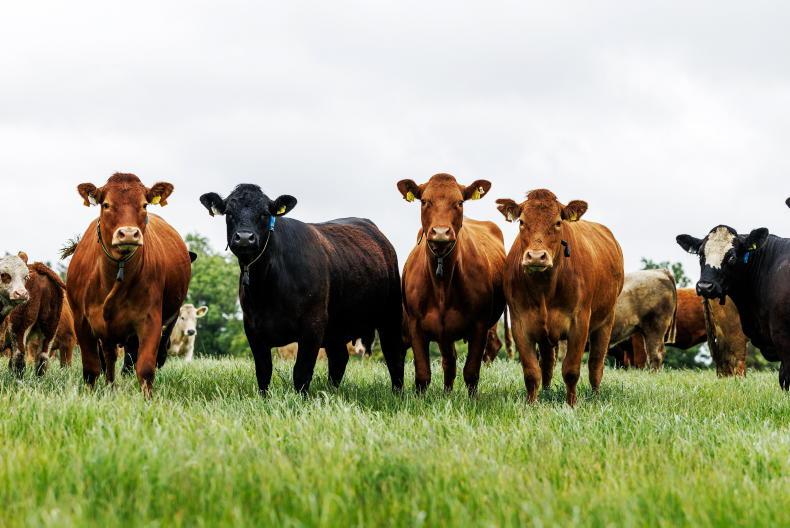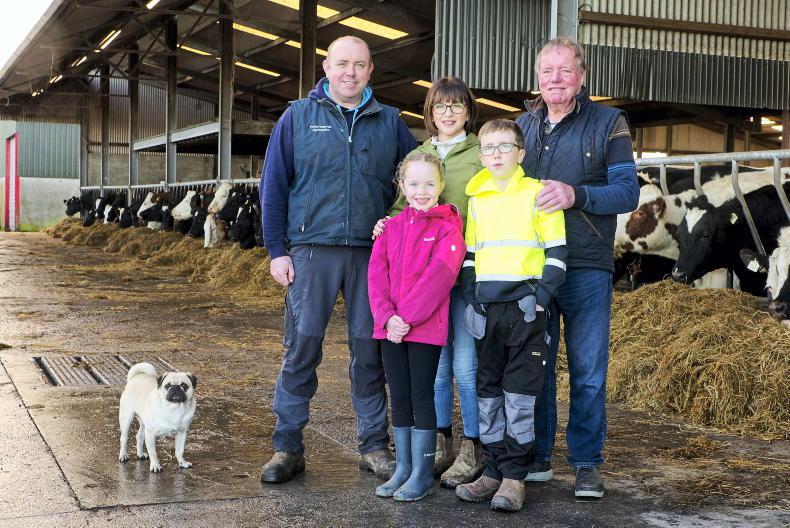Calving is well progressed on John Oliver’s farm near Limavady, Co Derry. There are 90 cows going through the parlour and eight cows are left to calve down.
The herd is in the process of gradually switching from a block autumn-calving system to a spring-calving profile. Breeding was delayed by two months last year and calving began in early November. John has 23 bought-in heifers that will be calving in a spring profile after the main herd has finished calving. The first of these heifers are due from 5 February.
The milking herd is averaging 32l from 11.5kg of concentrates. Cows are offered 5kg of blend through the wagon and are topped up through in-parlour feeders.
Freshly calved cows are gradually built up on parlour nuts over 21 days. Cows are then fed ahead of demand, to push yields for the first 100 days in a “lead-feed” programme. After that, a feed to yield rate of 0.45kg/l is used for in-parlour feeders.

Inset: Cows are currently averaging 32 litres from 11.5kg of meal.
Breeding in the main herd will be delayed by another two months this year, in the second step towards spring calving. The main reason for changing systems is to allow more grass to be utilised by the milking herd in the second half of the grazing season.
“The start date for breeding could be weather dependent, but it will probably be around early to mid-April. We want to start serving cows when we know they are at grass and it is unlikely that we will have to house them again,” John said.
Both tail paint and pedometer collars will be used for detecting heats. The plan is to use the long voluntary waiting period to carry out thorough pre-breeding checks from February on. Cows that are not cycling will be examined by a vet and those that showed limited signs of heat through either the tail paint or collars will be monitored closely at breeding.
John Oliver has recently weighed his heifer calves to assess their growth performance.
He wants to calve these heifers down at 24 months of age at 600kg liveweight.
To achieve this, a key target is to reach a pre-service liveweight of 360–400kg before 15 months of age. John has been focusing on young calves, where he aims to hit a pre-weaning liveweight gain of 0.8-0.9kg/calf/day.
Research has shown that calves that achieve this level of growth performance produce more milk and have longer lifespans than cows than calves with lower liveweight gain during the pre-weaning stage.
A summary of his calf performance is given in Table 1. Corresponding figures recorded in the 2019/20 calving season are also shown.
While weight gain among individual calves ranges from 0.4-0.9kg/day, average growth rates for calves born this season are below target and are lower than last year’s performance.
On reflection, John feels that calves may have received less milk replacer than they should have in the early part of the calving season.
The issue is being put down to how milk replacer was being mixed. Instead using a heaped scoopful to measure powder for two calves, a rounded scoopful was used. Although the difference may seem trivial or minor, it amounts to around 100g less milk replacer being fed to each calf.
Taking time to weigh calves allowed John to spot the below par growth rates early on. He has made changes to the calf feeding protocol and is ensuring that all calves are now receiving 800–900g of milk replacer per day.
The first seven calves will be weaned off milk replacer this week and a further 20 calves are due for weaning next week. All replacement heifer calves were born in the first six weeks and only beef-sired calves arrived from 12 December onwards.
Weigh scales
Maiden heifers were also run over the electronic weighing scales recently, and the average weight was 416kg. This is slightly above target for bulling, but the average age of the group was 16 months. This is older than usual, due to delay of the breeding season.
The average weight for the maiden heifer group represents a liveweight gain from birth of 0.77kg/day, which is well on target.
John had been feeding concentrates to some light maiden heifers at 3-4kg/day to help push on growth rates. Now that the weight figures confirm that all animals are on target, this will be scaled back to 1-2kg/day as they approach and go through the breeding programme.
Weekly round-up
Youngstock are weighed regularly on Dairylink farms, to make sure that liveweight targets are being met.Nutrition and management are reviewed if heifers are found to be below par.Programme farmers are conducting soil analysis and developing fertiliser plans ahead of the open period for slurry spreading.
Calving is well progressed on John Oliver’s farm near Limavady, Co Derry. There are 90 cows going through the parlour and eight cows are left to calve down.
The herd is in the process of gradually switching from a block autumn-calving system to a spring-calving profile. Breeding was delayed by two months last year and calving began in early November. John has 23 bought-in heifers that will be calving in a spring profile after the main herd has finished calving. The first of these heifers are due from 5 February.
The milking herd is averaging 32l from 11.5kg of concentrates. Cows are offered 5kg of blend through the wagon and are topped up through in-parlour feeders.
Freshly calved cows are gradually built up on parlour nuts over 21 days. Cows are then fed ahead of demand, to push yields for the first 100 days in a “lead-feed” programme. After that, a feed to yield rate of 0.45kg/l is used for in-parlour feeders.

Inset: Cows are currently averaging 32 litres from 11.5kg of meal.
Breeding in the main herd will be delayed by another two months this year, in the second step towards spring calving. The main reason for changing systems is to allow more grass to be utilised by the milking herd in the second half of the grazing season.
“The start date for breeding could be weather dependent, but it will probably be around early to mid-April. We want to start serving cows when we know they are at grass and it is unlikely that we will have to house them again,” John said.
Both tail paint and pedometer collars will be used for detecting heats. The plan is to use the long voluntary waiting period to carry out thorough pre-breeding checks from February on. Cows that are not cycling will be examined by a vet and those that showed limited signs of heat through either the tail paint or collars will be monitored closely at breeding.
John Oliver has recently weighed his heifer calves to assess their growth performance.
He wants to calve these heifers down at 24 months of age at 600kg liveweight.
To achieve this, a key target is to reach a pre-service liveweight of 360–400kg before 15 months of age. John has been focusing on young calves, where he aims to hit a pre-weaning liveweight gain of 0.8-0.9kg/calf/day.
Research has shown that calves that achieve this level of growth performance produce more milk and have longer lifespans than cows than calves with lower liveweight gain during the pre-weaning stage.
A summary of his calf performance is given in Table 1. Corresponding figures recorded in the 2019/20 calving season are also shown.
While weight gain among individual calves ranges from 0.4-0.9kg/day, average growth rates for calves born this season are below target and are lower than last year’s performance.
On reflection, John feels that calves may have received less milk replacer than they should have in the early part of the calving season.
The issue is being put down to how milk replacer was being mixed. Instead using a heaped scoopful to measure powder for two calves, a rounded scoopful was used. Although the difference may seem trivial or minor, it amounts to around 100g less milk replacer being fed to each calf.
Taking time to weigh calves allowed John to spot the below par growth rates early on. He has made changes to the calf feeding protocol and is ensuring that all calves are now receiving 800–900g of milk replacer per day.
The first seven calves will be weaned off milk replacer this week and a further 20 calves are due for weaning next week. All replacement heifer calves were born in the first six weeks and only beef-sired calves arrived from 12 December onwards.
Weigh scales
Maiden heifers were also run over the electronic weighing scales recently, and the average weight was 416kg. This is slightly above target for bulling, but the average age of the group was 16 months. This is older than usual, due to delay of the breeding season.
The average weight for the maiden heifer group represents a liveweight gain from birth of 0.77kg/day, which is well on target.
John had been feeding concentrates to some light maiden heifers at 3-4kg/day to help push on growth rates. Now that the weight figures confirm that all animals are on target, this will be scaled back to 1-2kg/day as they approach and go through the breeding programme.
Weekly round-up
Youngstock are weighed regularly on Dairylink farms, to make sure that liveweight targets are being met.Nutrition and management are reviewed if heifers are found to be below par.Programme farmers are conducting soil analysis and developing fertiliser plans ahead of the open period for slurry spreading. 










SHARING OPTIONS